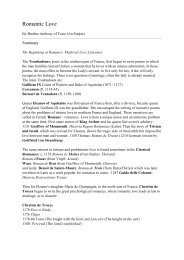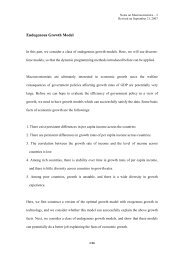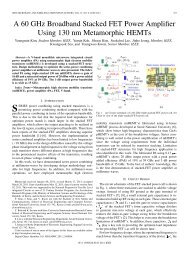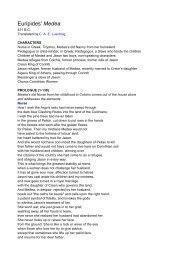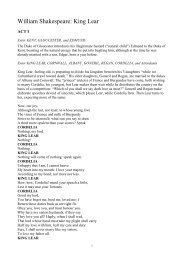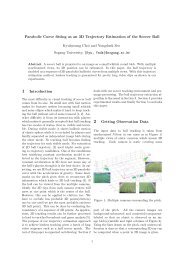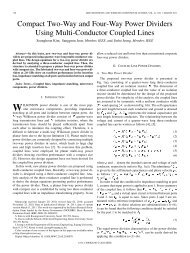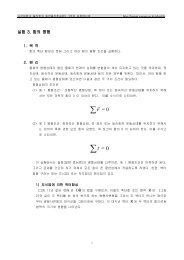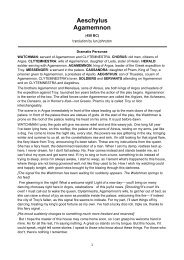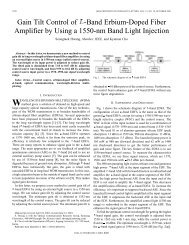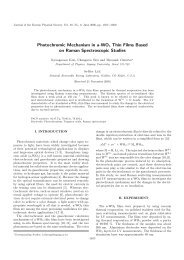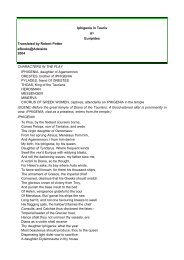THE KOREA REVIEW Volume 1, 1901 Homer B. Hulbert A.M. ...
THE KOREA REVIEW Volume 1, 1901 Homer B. Hulbert A.M. ...
THE KOREA REVIEW Volume 1, 1901 Homer B. Hulbert A.M. ...
Create successful ePaper yourself
Turn your PDF publications into a flip-book with our unique Google optimized e-Paper software.
the Han dynasty they spoke of Cho-sun, Chin-bun and Ye-mak. Mencius notice of a greater and lesser<br />
Mak is looked upon by some as an insult to the memory of Ki-ja, as if he had called Ki-ja’s kingdom a<br />
wild country; but the above mention of the three separately is quoted to show that Mencius had no<br />
such thought.<br />
The annals of Emperor Mu-je state, in a commentary, that Mak was north of Chin-han and<br />
south of Ko-gu-ryu and Ok-ju and had the sea to the east, a description which exactly suits Ye-mak as<br />
we know it.<br />
The wild tribe called Ok-ja occupied the territory east of Ka-ma San and lay along the<br />
eastern sea-coast, it was narrow and long, stretching a thousand li along the coast in the form of a<br />
hook. This well describes the contour of the coast from a point somewhat south of the present Wunsan<br />
northward along the shore of Ham-gyung Province. On its south was Ye-mak and on its north<br />
were the wild Eum-nu and Pu-yu tribes. It consisted of five thousand houses grouped in separate<br />
communities that were quite distinct from each other politically, and a sort of patriarchal government<br />
prevailed. The language was much like that of the people of Kogu-ryu.<br />
When Wi-man took Ki-jun’s kingdom, the Ok-ju people became subject to him, but later,<br />
when the Chinese made the jour provinces, Ok-ju was incorporated into Hyun-do. As Ok-ju was the<br />
most remote of all the wild tribes from the Chinese capital, a special governor was appointed over her,<br />
called a Tong-bu To-wi, and his seat of government was at Pul-la fortress. The district was divided<br />
into seven parts, all of which were east of Tan-dan Pass, perhaps the Ta-gwul Pass, of to-day. In the<br />
sixth year of the Emperor Kwang-mu, 31 A. D., it is said that the governorship was discontinued and<br />
native magnates were put at the head of affairs in each of the seven districts under the title Hu or<br />
Marquis. Three of the seven districts were Wha-ye, Ok-ju and Pul-la. It is said that the people of Yeguk<br />
were called in to build the government houses in these seven centers. [page 83]<br />
When Ko-gu-ryu took over all northern Korea, she placed a single governor over all this<br />
territory with the title Ta-in. Tribute was rendered in the form of grass-cloth, fish, salt and other sea<br />
products. Handsome women were also requisitioned. The land was fertile. It had a range of mountains<br />
at its back and the sea in front. Cereals grew abundantly. The people are described as being very<br />
vindictive. Spears were the weapons mostly used in fighting. Horses and cattle were scarce. The style<br />
of dress was the same as that of Ko-gu-ryu.<br />
When a girl reached the age of ten she was taken to the home of her future husband and<br />
brought up there. Having attained a marriageable age she returned home and her fiance then obtained<br />
her by paving the stipulated price.<br />
Dead bodies were buried in a shallow grave and when only the bones remained. they were<br />
exhumed and thrust into a huge hollowed tree trunk which formed the family “vault.” Many<br />
generations were thus buried in a single tree trunk. The opening was at the end of the trunk. A wooden<br />
image of the dead was carved and set beside this coffin and with it a bowl of grain.<br />
The northern part of Ok-ju was called Puk Ok-ju or “North Ok-ju.” The customs of these<br />
people were the same as those of the south except for some differences caused by the proximity of the<br />
Eum-nu tribe to the north, who were the Apaches of Korea. Every year these fierce people made a<br />
descent upon the villages of the peaceful Ok-ju, sweeping everything before them. So regular were<br />
these incursions that the Ok-ju people used to migrate to the mountains every summer, where they<br />
lived in caves as best they could, returning to their homes in the late autumn. The cold of winter held<br />
their enemies in check.<br />
We are told that a Chinese envoy once penetrated these remote regions. He asked “Are there<br />
any people living beyond this sea?” (meaning the Japan Sea.) They replied “Sometimes when we go<br />
out to-fish and a tempest strikes us we are driven ten days toward the east until we reach islands<br />
where men live whose language is strange and whose custom it is each summer to drown a young girl<br />
in the sea. Another said “Once some clothes floated here which were like ours except that the sleeves<br />
were as long as the height of a man.” [page 84]<br />
Another said “A boat once drifted here containing a man with a double face, one above the<br />
other. We could not understand his speech and as he refused to eat he soon expired.”<br />
The tribe of Ok-ju was finally absorbed in Ko-gu-ryu in the fourth year of King T’a-jo<br />
Wang.<br />
The Eum-nu tribe did not belong to Korea proper but as its territory was adjacent to Korea a




